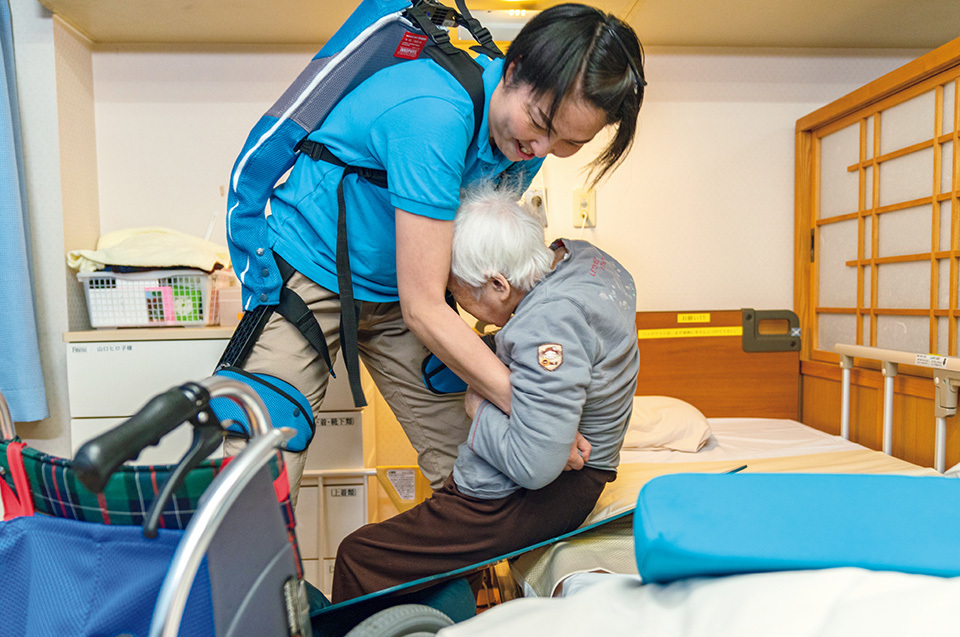Have you seen the latest Chinese blockbuster The Wandering Earth 2? If not, spoiler alert.
The film brings to life a classic science fiction trope: Exoskeletons.
While The Wandering Earth 2 is primarily a figment of the director's imagination, the depiction of exoskeletons is close to reality. Here's a little something: Due to the heavy load of the props for the outdoor set, the production team decided to transport them with exoskeletons developed by the Chinese robotics company ULS Robotics.
Active and passive exoskeletons, explained
In real life, exoskeletons are put on for the same reason as the characters in the movie: mobility support and assistance. They are therefore very applicable to the healthcare context. For example, patients with hemiplegia or limited mobility can be fitted with exoskeletons to control their range of motion, which could improve the effectiveness of physical rehabilitation.
Exoskeletons used in this context are commonly referred to as passive exoskeletons. These robotic wearables can be equipped to assist and train patients' physical activity during physical rehabilitation. Medical exoskeletons typically do not require electricity to function and are designed to address limitations. By restricting patients' physical movement at various points on their bodies, such as their knee joints, they help simulate natural gait, potentially improving rehabilitation outcomes.
Their weight-reducing and shock-absorbing properties can also help patients better manage the rigors of physical therapy sessions, especially for patients with significant physical immobility.
Medical exoskeletons were initially the focus of Zhenhua Xu, founder of ULS Robotics, when he began developing the technology. However, Xu found it difficult to overcome the technology's external limitations: high cost and lack of alternative use cases. At the time, exoskeletons were mainly used in hospitals and were prohibitively expensive for the average person, with each unit costing more than thousands of dollars.
In addition to medical applications, exoskeleton technology is finding relevance in both the military and industrial sectors. Factories in particular tend to be more open to promoting and implementing the technology, creating a more favorable environment for its growth.

Exoskeletons used for industrial activities may resemble what is conventionally regarded as "sci-fi armor". They fall under the category of active exoskeletons and are typically powered to enhance physical strength and endurance while retaining a flexible range of motion. Such exoskeletons are therefore useful when utilized to perform labor-intensive tasks such as construction and mining, particularly in non-deterministic scenarios.
Current exoskeletons deployed in industrial settings can be further categorized into two types: full-body and modular. Modular exoskeletons focus only on certain body parts, such as the waist or limbs. They can also be subcategorized based on the amount of assistance provided and are typically expressed in kilogram units, based on the weight reduction benefits:
There are other exoskeleton variations as well. For example, modular exoskeletons have been used to support workers' lumbar spines to reduce the incidence of spine-related occupational diseases.
According to Xu, ULS Robotics' exoskeleton products are designed to meet the needs of various sectors, including logistics, home appliance manufacturing, aviation logistics, power generation systems and more. Its exoskeletons are worn by miners, pipe layers and transporters, among others. For the average worker, who carries a load between 30 and 50 kilograms and bends over 1,000 times a day, exoskeletons can provide physical support that is potentially life-changing.

The road to mainstream acceptance
While ULS Robotics has received CE certification in Europe, indicating that its products meet European Union safety and quality standards, there is a long road ahead for the exoskeleton market, which is still underdeveloped in several areas, including software, hardware and other aspects such as raw materials.
In the meantime, ULS Robotics has continuously developed its exoskeleton products to optimize three key aspects: Cost, stability and compactness. In 2019, the first-generation waist exoskeleton weighed 10 kilograms and could support a maximum load of 20 kilograms. The latest version now weighs 5.8 kilograms and can support 50 % more weight (30 kilograms) than the original version.
The Chinese robotics company has also created an Internet-of-Things platform capable of managing exoskeletons while collecting real-time data. The platform provides a customizable user experience that allows them to adjust their settings to a variety of use cases. For example, users can customize the weight support provided by an exoskeleton on any part of the body, such as the hips, arms and legs. The software also enables motion and environment tracking, making it easier to analyze movement intent.
ULS Robotics is not alone in the field of exoskeleton development. Ottobock, a German orthopedic technology company, and Innophys, a Japanese company, are examples of other exoskeleton technology developers. Multinational corporations such as Samsung and Honda are also exploring the use of exoskeletons to provide physical and mobility support to the elderly.

The tipping point, with exoskeleton technology still in the early stages of development, will likely depend on its acceptance by the general population in the near future, according to Xu.
In industry, exoskeletons can complement unmanned or autonomous robotics, improving human-robot interactions while predicting and adapting to behavior patterns. They can also be used by workers who need to adapt quickly to changes in their environment, especially workers who work in manufacturing, logistics, and chemical industries. Exoskeletons can improve their efficiency while reducing the risk of occupational hazards.
In addition, in countries with an aging workforce such as Japan, South Korea, and parts of Europe and the U.S., occupational health and safety laws and a growing emphasis on health and safety offer opportunities to drive demand for exoskeleton products.
Nonetheless, the timeline for reaching exoskeleton technology maturity varies from company to company, depending on hardware and software considerations.
When it comes to hardware, specialized companies can have significant advantages in terms of technical details and designs.
The main problem that remains for most companies in this field is their lack of chip production capacity.
Specific to ULS Robotics, its expertise is in software, having independently developed its core exoskeleton technology and filed over 40 patents and software copyrights in just a few years. Its efforts have not gone unnoticed, as the company recently completed its Series A round to fund new product development and its marketing efforts.
Source: No more science fiction: exoskeletons are ready to assist humans | KrASIA (kr-asia.com)
